How to pick your locations for photography
A few days ago I walked to get morning coffee in Sultanahmet in Istanbul, in a place just behind the famous Blue Mosque. A carpet seller was offended I didn't pass by him on the street where the tourists normally go but instead headed for a hidden back road. "Why are you going that way? Nothing happens over there!" he yelled, and with that – without knowing it – he revealed the existence of the parallel universe I was about to explore.
I knew what I was doing. I was deliberately avoiding the tourist crowds. Already at this early hour 8AM, six busses had just parked on the side and were offloading 250 tourists who immediately followed their leader with the flag, as newborn born ducks in rows.
By walking via the back street where "there was nothing to see", I was following my usual path, and the path from last night where I got the photo below, and I wanted to see what I could do in daylight.
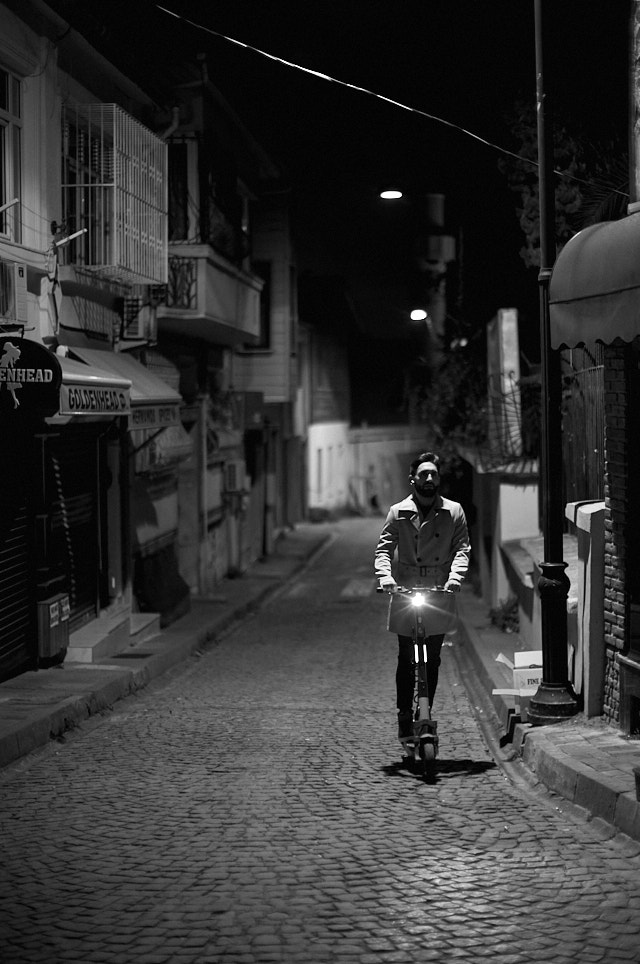
Night in a narrow back street in Sultanahmet in Istanbul. Leica M11 with Leica 50mm Noctilux-M ASPH f/0.95. © Thorsten Overgaard.
What happened last night was that I walked this way, and I saw this frame: The cobblestone street with light and shadows, framed with small buildings.
I stopped, took a test photo to set my exposure correct. Then I sat my focus on the lamp post and waited: Whatever would be coming, I would photograph 2-3 pictures the instant a person, scooter or car came into the focus line of the lamp post.
Few seconds later, this person came strolling on his two-wheeler. And then after that, nothing happened for minutes. It could have been the other way around; that nothing happened within this beautiful scene for the next 30 minutes. And I would have gotten nothing, because I would probably have given it 2-3 minutes of my time to wait and see what would happen.
| |
|
|
|
|
|
|
 |
|
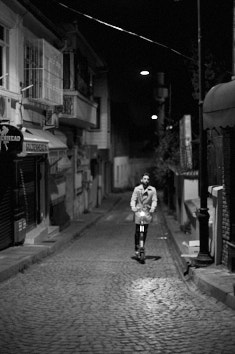 |
|
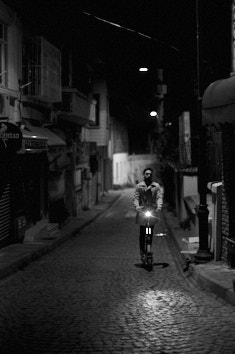 |
|
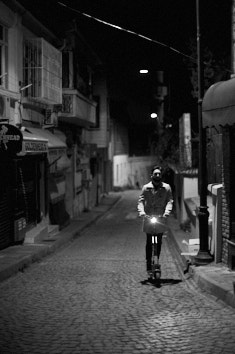 |
| Setting the scene: First I set the exposure, frame and focus. |
|
Taking the photo: Then, once something happens in the frame, I take 2-3-4 photos. Also notice how the street light is blinking, invisible to the eye, but it is changing the scene from one frame to the next. |
| |
|
|
|
|
|
|
I take series of photos not only to nail the focus. I take series also because the rhythm changes (where the feet and hands are), the light changes, the facial expression changes. So you work with nailing the overall scene, then leave to coincidence what happens in the 1-2 seconds you are taking a series of 3-4 photos.
Then I usually wait for the next person or thing to enter the frame. I'll do this for as long as I find i worthwhile. Sometimes my patience and hope is half a minute, at other time 10 minutes. You can only be at one place at a time, so either you stay on one spot and miss another opportunity happening 20 minutes into the future. Or you get on with the show, heading to the next possible photos, without getting his one. So much in photography is about making choices.
I often also return to a scene again. A year later when the light and weather is the same, or next day at the same time. Or at another time where the light could be expected to be better.
Leave me alone
I love that the guy on the street yelled at me, "There's nothing to see there", because he is quite right. There is nothing to see; there is so much emptiness that you can make anything out of it.
Which leads me to the point of this article: The best photo locations are quiet streets, narrow streets, old and unplanned infrastructure. These offer all sorts of interesting angels, light compositions and scenes, and often the real local life in any city is found in the small streets.
I want to be left alone when I photograph. Just leave me the heck alone. This is is where you observe and see pictures and can wrap your mind around the idea of what it could become.
If there is too much commercial activity, to many guided signs, too many architects who have planned where to put the lamps and the trash cans, nothing really happens. Visually speaking. How could you possibly compose something unique out of something that clearly isn't?
Noisy and happening places are "filling the frame automatically" and that is not a good thing. Stillness allow for you to observe, decide and execute your photos.
Small streets. You walk, you turn a corner, you find the interesting route. On the way you stumble into local life, cute cafes, specialty stores, funny local people and activities, cats sleeping on the roof of a car, laundry hanging from third floor.
For some odd reason, Google maps – even when you walk – suggest main roads. It make sense when driving that the fastest and easiest way is the main routes. But for walking, they should be avoided. You look at the route Google suggest, and you look for how to reroute yourself via small streets.
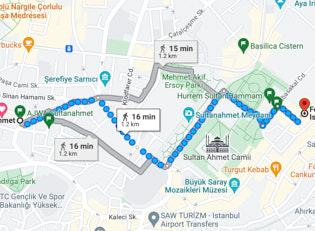 |
|
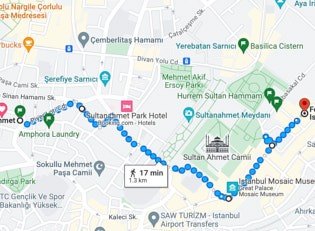 |
| Google maps say go this way |
|
You reroute yourself to the small streets |
| |
|
|
Or, you go in that direction, approximately. You get lost for a minute or two, then you look at the map to get back on track. Approximately. The road is the goal.
The rule is, that the wider the road and the more people that travel it, the least interesting it will be. Photography is like life. It's not about getting to the end of it and then you'll have alle the experience and have it all figured out. It's in the daily life you learn, and it is in the daily life you experience the small moments you will remember. If you recall your childhood, it's not the expensive moments your parents arranged for you that stand out. It's the most odd unimportant things that stand out as the most memorable.
This will be confirmed if you look at iconic photographs taken through history. They're never from The Blue Mosque or any other place "you must see". The best ones are unimportant people in unknown places doing everyday things.
"You must see ..."
No you don't. People will often suggest busy and messy areas they would never go themselves, but which are considered must see areas and things. It's just incomprehensible for a tuk-tuk driver why you would want to go see empty streets with beautiful light and not the historic places with too many tourists in ugly t-shirts and shorts. Everybody wants to go there, so clearly you must too.
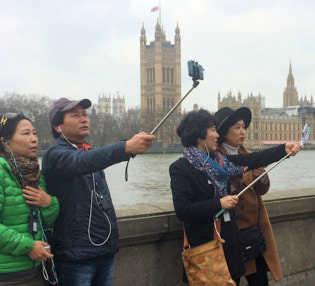 |
|
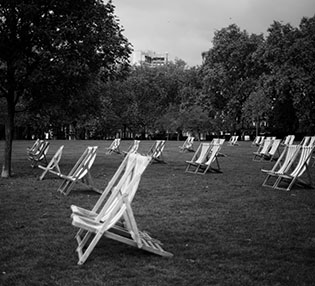 |
| They say you must go here |
|
So you go here |
| |
|
|
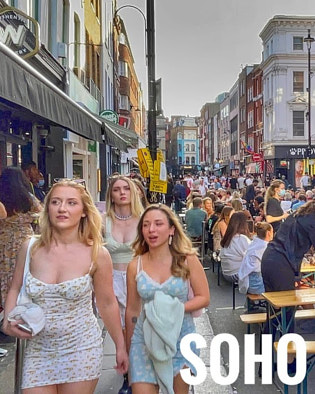 |
|
 |
| They say you must go here |
|
So you go here |
| |
|
|
The art of getting lost
Pick small streets, pick the quiet areas, pick the places even locals forget is there. Follow your intuition and go in whichever direction you have an idea could be something interesting and unknown.
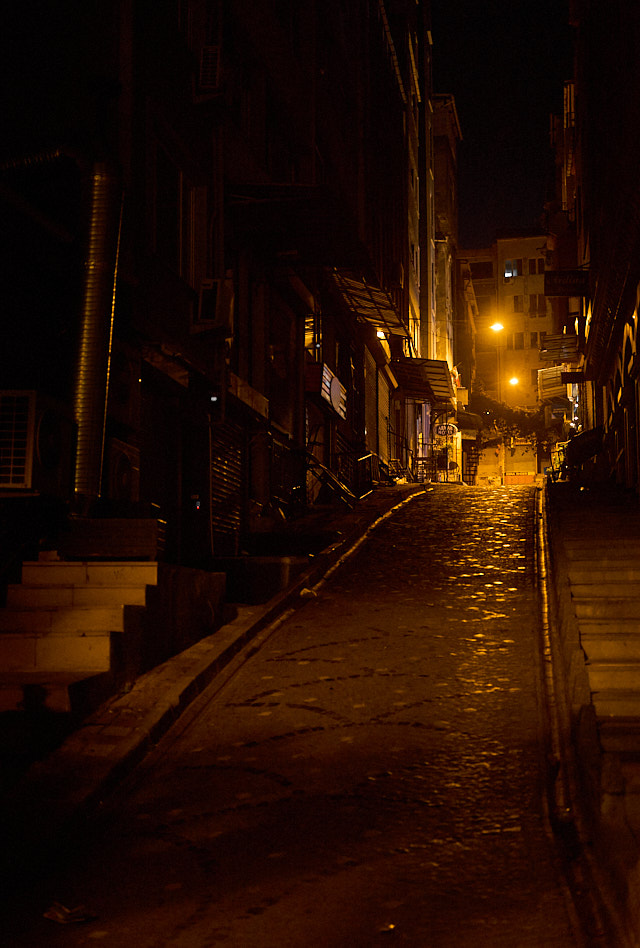
So nice and quiet: An empty street after midnight in Istanbul. The kind of locations you don't find in tourist guides but by which are everywhere i if you observe what is in front of you. You see this and you know this could be a stage for something. Leica M10-R with Leica 50mm APO-Summicron-M f/2.0. © Thorsten Overgaard.
Photography should be easy
The difference between play and work is that play is fun and work is no fun. Walking around and always wearing a camera, and occasionally making a good photo should be easy. It shouldn't be hard or difficult. If it is, its not your style.
A style, simply put, is to do what is truly you. Do what is obvious to you, and if you are afraid it will be too unrevolutionary, don't be so. It's only common looking to you because you see it all the time. When you take the photos and show others, they will be surprised because they never saw it that way.
"The writer's job is to tell the truth," Ernest Hemingway once said. "All you have to do is write one true sentence. Write the truest sentence that you know," and I find that applicable to photography as another form of expression.
Most people are following the flag to see what it out there in the world. When you have a camera, you are holding the flag and people will follow to see what you want them to see.
More to come
Bon voyage with it all. Sign up for the newsletter to stay in the know. As always, feel free to email me with suggestions, questions and ideas.
/Thorsten Overgaard
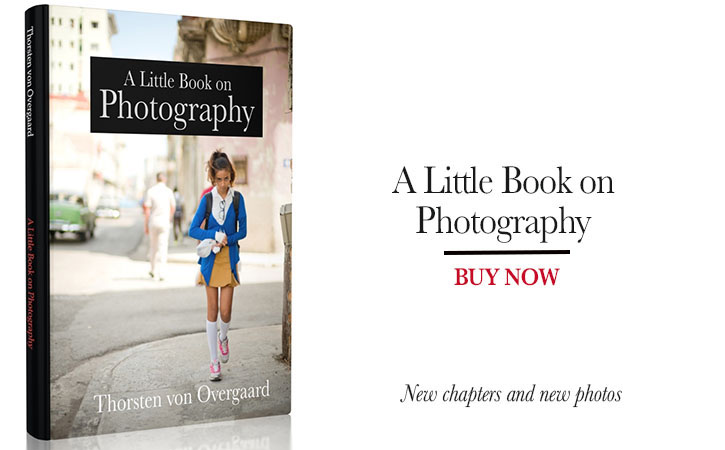
![]()
